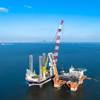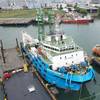Fair Weather Collision Attributed to Distracted Bridge Watch Officers
The bridge watch officers on a bulk carrier and an offshore supply vessel were not maintaining a proper lookout before the vessels collided last year near Port Fourchon, Louisiana, the National Transportation Safety Board (NTSB) has concluded.
On July 23, 2022, the bulk carrier Bunun Queen was transiting eastbound in the Gulf of Mexico and the offshore supply vessel Thunder was transiting northbound when the vessels collided. The Thunder sustained substantial damage to its port side, which resulted in the flooding of one of its propulsion rooms and three other spaces. No injuries or pollution were reported. The collision resulted in $12.3 million in damages to both vessels.
The collision occurred in good visibility, daylight and fair-weather conditions. Each of the vessel’s automatic radar and plotting aid displays and automatic identification system receivers were able to detect the other vessel. In the time leading up to the collision, neither of the vessels’ officer on watch maintained a lookout either by visual scanning or using the available electronic systems to prevent a collision.
Both officers on watch stated they were engaged in non-navigational tasks. The master on the Thunder was using his cell phone and the second officer on the Bunun Queen was engaged in other duties.
At the time of the collision, the Bunun Queen was in autopilot mode, and there was no recorded change of engine telegraph (still at navigation full ahead) or rudder order. About 18 seconds after impact, the second officer engaged manual steering and turned the rudder hard to port. About 30 seconds after impact, the master of the Bunun Queen (who said he was resting in his cabin at the time) arrived on the bridge.
The Convention on the International Regulations for Preventing Collisions at Sea requires “every vessel shall at all times maintain a proper lookout by sight and hearing as well as by all available means appropriate.”
The NTSB determined the probable cause of the collision was the Bunun Queen officer’s distraction due to performing non-navigational tasks and the Thunder officer’s distraction due to cell phone use, which kept both officers from keeping a proper lookout.
On both the Thunder and Bunun Queen, a single individual occupied the bridge. The company policy for the Bunun Queen allowed, with conditions, the bridge to be occupied by a sole watchstander, which the master approved. For the Thunder, the master’s standing orders required at least two people on the bridge when underway. As such, the master of the Thunder violated his own standing orders by allowing himself to be the sole watchstander on the bridge. Had either vessel had an additional person on the bridge, it is likely that at least one vessel’s crew would have sighted the other vessel.
“Using cell phones and other personal electronic devices has been demonstrated to be visually, manually, and cognitively distracted,” the report said. “Non-operational use of cell phones and other wireless electronic devices by on-duty crewmembers in safety-critical positions has been a factor in accidents in all transportation modes. Non-operational use of cell phones should never interfere with the primary task of a watchstander or a bridge team member to maintain a proper lookout.”















